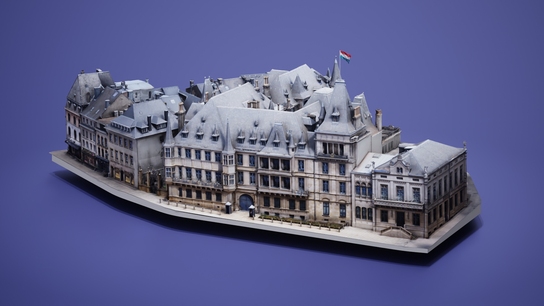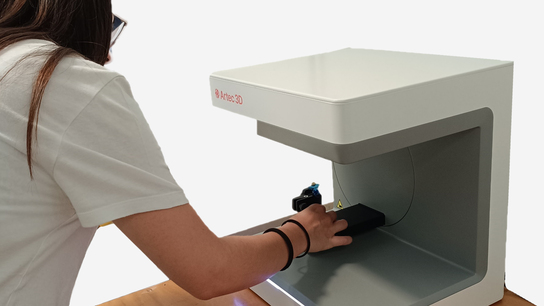Creating an ultra-detailed 3D/CT-scanned model of an ancient Egyptian mummy
The Goal: To create a complex 3D model of the mummy by merging a 3D digital scan together with a CT scan, while no contact with the mummy allowed during the process.
Tools Used: Artec Eva, Artec Studio, CT scanner, Volume Graphics software
The previously separated worlds of 3D scanning and computed tomography have come together to bring forth a unique collated model, one of an ancient Egyptian mummy. The info about the geometry and texture, or color, of the mummy, collected with Artec Eva 3D scanner, was laid over a computed tomography scan, made with an AXIOM Siemens CT scanner. The result is a digital copy of the mummy, which shows how it looks on the outside and inside.
Artec 3D and Volume Graphics combine a textured 3D scan of an ancient Egyptian mummy with its computed tomography scan to obtain the mummy’s most accurate 3D model to date, which shows its detail both on the outside and inside in one same model.
While delivering all-encompassing detail about the inner structure of the body, a CT scanner cannot render colors, falling short of producing a fully realistic representation of the object. Now, thanks to a new feature in Volume Graphics Version 3.1 software, which is a leader in the market of analysis and visualization of industrial 3D CT data, the two datasets can be merged with a click of a button.
The Sherit mummy project is one of the first applications of this new feature. Sherit, ancient Egyptian for “little one,” is a mummified Egyptian child who died two millennia ago. It currently resides at the Rosicrucian Egyptian Museum in San Jose, California.
“For us, the value of this project is to bring this little girl’s story to life,” says Julie Scott, Executive Director of the Rosicrucian Egyptian Museum. “She came to our museum in the 1930s, yet we knew very little about her. We wanted to find a way to learn more about who she was without damaging her mummy wrappings.”

The mummy Sherit as a combined representation of CT and optical scan: The light blue mesh is for illustrative purposes only. It symbolizes the now possible combination of colored 3D surface scans and the internal three-dimensional data obtained by a CT scan.
Sherit underwent CT scanning in 2005, which allowed researchers to determine her approximate age and state of health. The girl was between four and a half and six years old when she died. Her body was wrapped in fine linen and covered with round earrings, an amulet, and a Roman period necklace, suggesting she came from a wealthy family. The physicians involved in the research believe she probably died from dysentery or meningitis.
“Currently we present a video of this research in the science corner of the museum,” says Julie Scott. “We plan to present a new video there soon. The new presentation will be much more interactive. Our hope is that this new technology will help inspire guests to deeply relate to this little girl who lived so many years ago.”
The CT scan of Sherit was merged with a high-precision 3D scan, taken with Artec Eva handheld 3D scanner, which gave a vivid full-color 3D image of the outer surface of the mummy.
“We chose the Artec scanner because it’s one of the best ways to enhance the detail of a CT scan with a colored surface mesh which we could then import in the latest version of our VGSTUDIO MAX software,” says Christof Reinhart, CEO of Volume Graphics. “The easy-to-use Artec scanner combines compactness with high-quality surface capturing. The handling of the device is super convenient because of its relatively small size and high capturing speed. At the same time, it enables us to capture the surface of the object in 3D with high precision and, most importantly, in color – the one dimension still missing in CT. We’re extremely satisfied with the results. The quality exceeded our expectations.”
The use of Artec’s structured-light 3D scanning technology allowed for making a quick scan without having to attach targets to the fragile surface of the mummy. Artec 3D scanners deliver high-resolution 3D images with the 24 bits per pixel color depth, showing the object’s true colors, and thanks to the improved visualization feature in Artec Studio 12 software, the user working with the 3D data can view it as fully rendered scans, not as point clouds, upon rotation, which makes it much more convenient to edit and inspect the 3D model.
“This mummy was pretty easy to scan since it featured complex geometry, varied, non-repetitive texture, and natural surface imperfections,” says Artec’s Anna Galdina, who scanned the mummy. “The only minor difficulty I faced was the museum’s request not to hold the scanner above the mummy. This limited the scope of angles I could capture, but thanks to the scanner’s versatility it was no big deal.”

Scanning the Sherit mummy with Artec Eva, powered by Artec battery pack.
Anna had 30 minutes to complete the scanning but it was done much faster – in less than 10 minutes. “I then decided to make a few extra scans, tweaking the settings in Artec Studio, in order to see how it’s going to work,” she says. “Also, I used the remaining time to double-check if I captured all the cracks and cavities.”
Initial processing of the raw data was done on-site in just a few minutes. “When we got back to the office we processed higher resolution version in about 1.5 hours,” Anna says. “The client wanted several versions of the model in different resolutions, which I prepared afterward as well.”
Anna made a total of five models in .obj with .png textures, .ply, and .wrl, sizes ranging from 600,000 to 27 million polygons. “Overall, I was very excited to participate in this project,” she says. “I’ve never seen Artec 3D scans merged with CT scans before. The results are amazing! Both datasets were aligned perfectly well against each other, and now you can see every detail of the outer surface of the mummy and also see what it holds inside – that’s incredible!”

The 3D model of the Sherit mummy, created with Artec Eva 3D scanner, rendered in Artec Studio 12 software.
The 3D image was saved as a textured mesh, which contains both color and geometrical data. The CT scan detected the complete internal structure of the mummy nondestructively, an area which remained hidden to the optical 3D scanner. From the CT scan, the three-dimensional volume was calculated, which included all material and geometric information.
Then, all that was left to do was combine both scans into a single 3D model. For this, the textured mesh was placed on the surface of the object calculated from the CT scan. The result was a mummy that is the most exact digital copy of the original to date, both on the outside and inside.
All the merging work was done in VGSTUDIO MAX, Volume Graphics’ high-end software for the visualization and analysis of industrial CT data, whose latest version can read .obj and .ply data.
“It will be thrilling to see what the users of our software will do now that they’re able to add another dimension to their volume data,” says Christof Reinhart. “By adding colored point clouds as well as meshes, we are merging the worlds of optical and CT scanners. We are very excited to see how this function will be used!”
Previously, CT-scanned objects had to be manually colored in order to give the surface a realistic look, but this step is no longer required if you use the combination of 3D textured scanning and CT scans. Textured meshes can be imported into the Volume Graphics Version 3.1 software and merged with CT data for a more meaningful documentation, a more life-like, accurate representation, and comprehensive visual analysis of the object.
Obvious fields of application are protection of cultural heritage, forensics, archeology, anthropology, as well as medical sciences. However, there are possible industrial applications, as well. For example, the combination of textured meshes with CT can be used to examine details on the inside of an object in context with color details on the surface.
Scanners behind the story
Try out the world's leading handheld 3D scanners.





